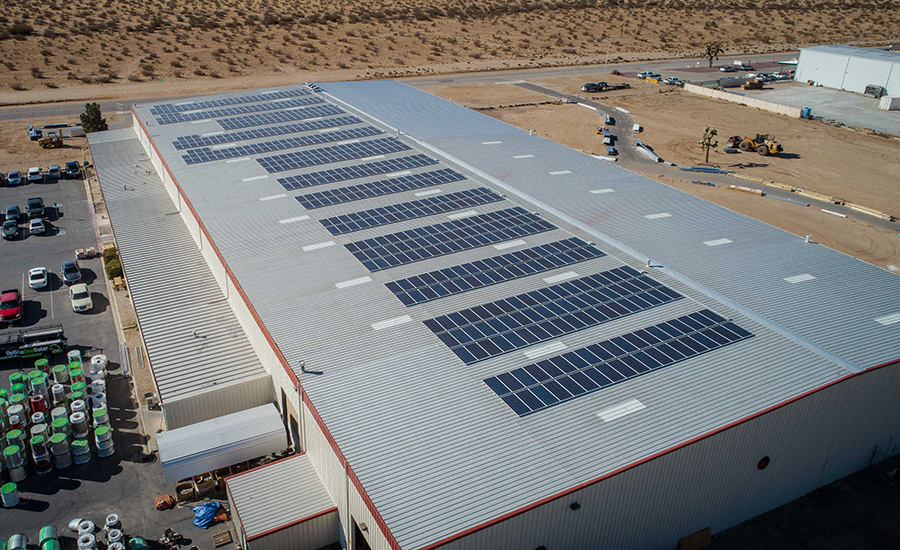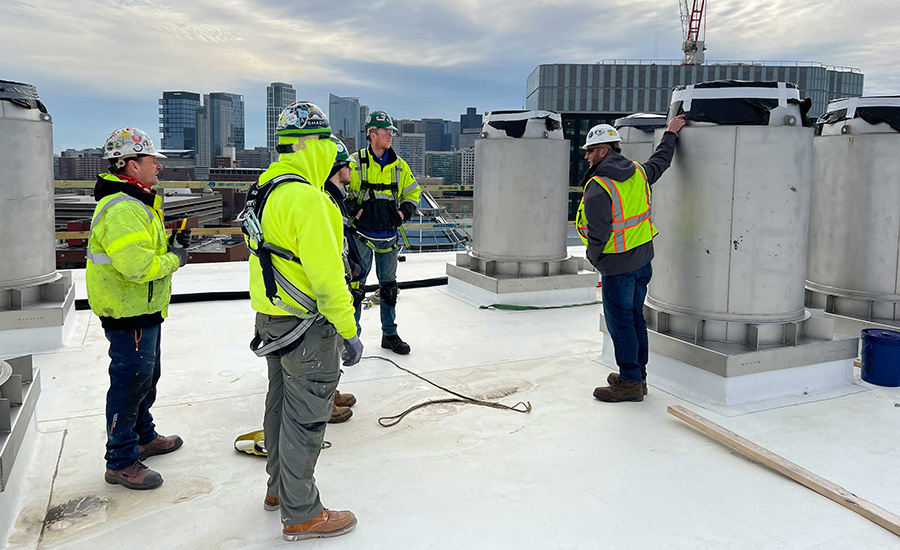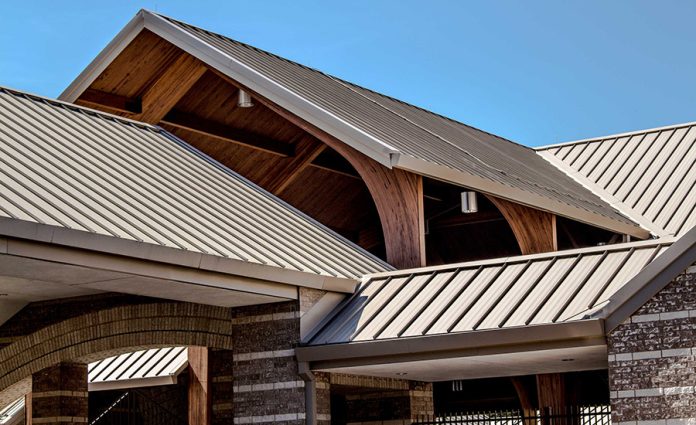Many
businesses — even entire industries — felt the impact of a strained
economy punctuated by record inflation, spiking interest rates and
overarching fears of a national recession in 2023. Still, commercial
roofing contractors didn’t appear to be among them. Both anecdotally and
undergirded empirically by data compiled late this year, commercial
roofers are confident about their chances for success in 2024 and
beyond.
“Business is gangbusters right now,” said Dave Reginelli,
president and CEO of Tecta America. The international commercial roofing
contractor led RC’s 2023 Top 100 List with a record $1.2
billion in revenue last year. “Supply chains have loosened, up we’re
hitting on all cylinders, and our backlog isn’t at record levels, but
it’s very close.”
Like Tecta, commercial roofers, influenced by
the material shortages and price volatility that followed the global
slowdown brought by COVID-19, essentially saw conditions improve by the
third quarter in most markets.
While other negative factors
threatened the overall economy, commercial roofing stayed resilient and
on par with the broader construction and repair/restoration fields. As
those segments returned to full swing, opportunities continued for
roofing contractors that had the capacity — and crew — to keep pace in a
new world of work. Some pundits predict commercial roofing itself could
exceed $10.3 billion in revenue domestically next year.
Yet,
challenges remain, particularly in the aforementioned “pinch point” of
labor availability, where commercial roofers are getting bold in their
continuous hunt for skilled employees to help clear backlogs while
building a pipeline of jobs for the future.
Once again, with the help of experts from Clear Seas Research — the survey and research arm of RC’s
parent company, BNP Media — roofing contractors nationwide told us
about the year they had and expectations for the future with our annual
roofing survey.
The series of questions designed and circulated
last fall helped parce the challenges encountered during this year into
perspective while pinpointing trends that may help lead the way to
success in 2024. Respondents consisted of roofing contractors that
subscribe to RC and are registered on roofingcontractor.com.
The
commercial roofing contractors who responded represent companies that
generate more than 50% of overall annual revenue from commercial
projects — whether that be in roof replacement, repair or new
construction. The majority were men, at 69%, and nearly 35% were between
ages 40-49, the largest age group of respondents this year.
The
South led the geographic breakdown at 38%, followed by the Midwest at
31%, the West at 18%, and the Northeast at 13%. Roughly four-in-10
respondents identified themselves as corporate/executive management, and
another 20% identified themselves as general managers.
Survey results show growth in commercial sales of metal roofing systems; the expectation of metal accessories use indicates growth in 2024 compared to data from the previous two years.
Sales Outlook
Roofing
sales in the commercial space continued to surge this year as the
overall economy picked up steam. Roughly three out of four survey
respondents indicated sales increased or remained flat in 2023, and 26%
said they projected sales to greatly increase year-over-year.
About
the same number of contractors, 74%, said they expected annual sales
volume to increase next year, and 85% said sales should improve over the
next three years.
Nearly 10% said they expected to see a decrease
in sales volume this year, including 4% anticipating sales to decrease
significantly. About 7% anticipate further drops in 2024 and over the
next three years. Those numbers remain relatively consistent with
results from previous surveys.
Of those displaying optimism, the
majority, 53%, said revenues would just slightly increase in 2024, and
even more, 68%, expected slight increases through 2026. Geographic
headquarters appeared to have little influence in the reporting: in the
regional breakout, more than half of all contractors spread across the
Northeast, Midwest, South and West anticipated sales growth at year’s
end.
At least 60% or more contractors across the same territories
expected sales increases in 2024, extending throughout the next three
years. Roughly 73% of contractors in the Midwest and West said sales
volume would grow through 2026.
A Single-Ply Space
If
there were complaints from contractors displeased with sales this year
compared to last, they likely weren’t in single-ply roofing. The go-to
commercial installation system again dominated the survey field, with
81% of respondents using it. Single-ply also accounted for the highest
percentage of revenue generated by commercial roofers in the survey at
36%.
The data showed that 41% of contractors installing TPO
systems drove single-ply sales, followed by EPDM at 30%, PVC at 17%, and
KEE at 10%. On average, nearly half of low-slope asphalt sales, 48%,
are comprised of modified bitumen-SBS, with modified bitumen-APP at 27%
and built-up roofing not far behind at 25%.
Nearly three-quarters
of respondents, 71%, said they use low-slope asphalt, accounting for
roughly 10% of revenue; similar figures involving contractors using
single-ply roofing indicated they expect commercial sales to increase in
2024.
Coatings use among respondents, at 59%, dipped slightly
from last year, but polymer-synthetic roofs, 41%, and slate roofs, 37%,
demonstrated double-digit gains in popularity among commercial roofers
represented in the data. Coatings sales among contractors already using
them remain strong. More than half, 54%, said sales boosted in 2023, and
60% expected sales to increase next year.
Results show growth in
commercial sales of metal roofing systems; the expectation of metal
accessories use also indicates anticipated growth in 2024 compared to
data from the previous two years. Growth in both slate and solar is more
bearish, with expected declines in each category.
About 79% of respondents said they install metal roofs, accounting for 13% of their overall revenue.
Breaking
it down by product, architectural standing seam projects accounted for
40% of commercial sales, while roof edge and gutters were not far behind
at 28%. Structural standing seam projects were next, at 23%, followed
last by metal architectural shingles and tile.
On the
sustainability side, nearly 72% of contractors involved in solar said
sales increased in 2023. Only half, however, said they expected solar
sales to increase in 2024. About one-third of respondents, 33%, said
garden roofing sales should increase next year, as did a similar number
of contractors, 32%, that use wood shake on some installations.

Survey data indicates despite an overall increase in popularity, only 48% of commercial contractors expect sales to increase in 2024.
Perceived Challenges
Along
with all the positive sales indicators, the survey data reflects some
significant challenges contractors will have to overcome to be
successful in 2024. It starts with perceptions of the overall U.S.
economy, which has shown consistent job growth but continues to flail
due to inflation and record-high interest rates. Just more than half of
commercial roofers, 51%, cited the “current economy/inflation” as a
chief concern this year. That number jumped from 38% in the 2022 survey
and grew for the second consecutive year.
Keeping pace — also at
51% — were increased building material costs and a lack of qualified
workers. In all, more than 40% of total survey respondents said current
economic conditions, material costs and workforce were a concern,
followed by more than 37% worried about lowball pricing.
Supply
chain problems and material shortages rounded out the top five at 22%
among commercial roofers. That represents a significant drop from last
year’s survey results, where nearly three-quarters, 71%, noted increased
building material costs and more than half, 56%, said supply shortages
were top of mind heading into 2023.
While there exists concern
nationally about reduced occupancy rates in retail and commercial
spaces, fears about people’s changing work habits in a post-pandemic
world are not impacting demand for commercial roofing work.
“It
doesn’t seem that the low occupancy is affecting demand at this juncture
because the insurance carrier is still requiring inspections on roofs
whether the building is occupied or not,” said Kyle Johnson, sales
director of Florida-based R/J Group Inc.
However, Johnson has
heard from building owners who said they cannot secure ancillary
insurance products like a wind rider or coverage for wind events unless
the building is occupied or has a lessee in place.

Despite more offices closing as people work from home, anecdotal evidence suggests commercial roofing inspections and business are still high.
Workers
aren’t just becoming more challenging to find, but they’re also costing
more, data shows. Roughly 70% of respondents reported higher labor
costs since January, with an average increase of about 17% among
commercial roofers.
The majority of work, 60%, is completed by
full-time employees, while 31% of commercial roofers rely on
subcontractors; part-timers round out the remaining work.
Some
roofing contractors, however, are getting creative and are taking a
long-term approach to building a workforce from within. California-based
Madsen Roofing & Waterproofing recently purchased a separate
building intended for dual uses — warehousing materials and
multi-faceted training. One side of the facility operates like a
classroom with flexible seating and also has an open space that’s ideal
for hands-on demonstrations and practice.
The idea is to pair
less-experienced or less-skilled crewmembers with a foreman in an
environment where they can practice proficiency with certain materials
they’ll use on the job site.
“We’ve had some really good success
with that, and the crew members, they love it,” said Madsen Roofing CEO
Christian Madsen. “They feel like we’re investing in them and their
future, and it gives them the ability to earn higher wages.”
Survey
data showed more than half of respondents rely on formal, in-house
training, as well as manufacturer training. Another 53% use training
provided by industry associations, and 35% use apprenticeships to build
up their crews.
Conclusions
With
supply-chain issues fading from view, the sales data from this year’s
survey shows that commercial roofing contractors are pushing hard to
maintain a pipeline of jobs, justifying a high level of optimism when it
comes to demand. Still, the industry’s workforce woes continue and seem
exacerbated by a post-pandemic “new reality” economy. Roofers said it
is impacting scheduling, but that’s not always a negative, some pointed
out.
One positive aspect for commercial contractors dealing with
an absence of readily available labor has been that companies focusing
on sales while sustaining an available backlog can extend roofing demand
further into the future.
Ensuring steady work can help stabilize
budgets and planning, but survey data shows it’s becoming just as
important as safety to commercial roofers in terms of employee
retention.
Roofing contractors like the R/J Group are ready to
capitalize on that strategy by investing in growth opportunities and
customer care. Johnson said they’ve already added a national accounts
manager and a dedicated service manager who will act as a roofing
“liaison” to help customers navigate through roofing issues — whether
aiding in budget projections, technical details or general inquiries.
“There
is a ton of optimism in the industry for the foreseeable future
pertaining to demand,” Johnson explained. “Commercial roofing is a niche
market, and few companies do commercial roofing with high quality, and
we’re projecting the demand for such services to be quite strong.”
Getting
more competent workers into the field is a must for contractors to
capitalize. The majority of companies represented in the survey indicate
employee referrals are the most common way to identify and recruit
roofing job candidates.
About 70% of commercial roofers use online
job posts or social media to recruit. The other top strategies for
employee retention include incentive pay and bonuses, the ability to
ensure future work, and prioritizing safety.
Commercial roofing
contractors are also driving the surge in estimating, enterprise and
accounting software flooding the industry. They will need all these
tools moving forward as the commercial roofing market puts a premium on
efficiency and stays cautious about costs.
Editor’s Note: Information contained within this article comes from Clear Seas Research. 2023 Roofing Contractor Commercial Roofing Report. Oct. 2023.
Clear
Seas Research is a full service, B-to-B market research company focused
on making the complex clear. Custom research solutions include brand
positioning, new product development, customer experiences and marketing
effectiveness solutions. Clear Seas offers a broad portfolio of
primary, syndicated research reports and powers the leading B-to-B panel
for corporate researchers, myCLEARopinion Panel, in the architecture,
engineering, construction, food, beverage, manufacturing, packaging and
security industries. Learn more at clearseasresearch.com.
www.roofingcontractor.com
https://www.roofingcontractor.com/articles/98956-2023-commercial-roofing-trends-report













